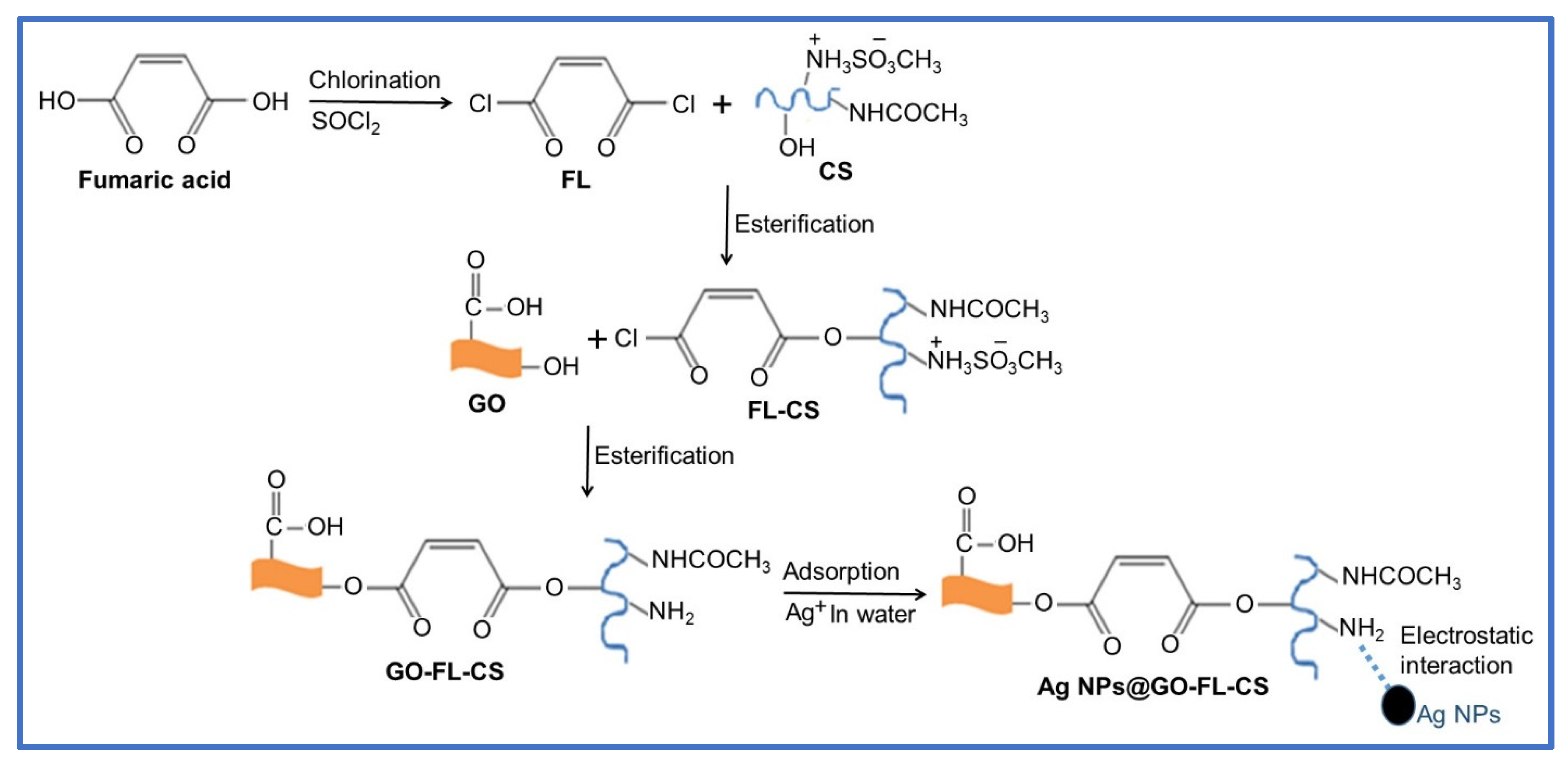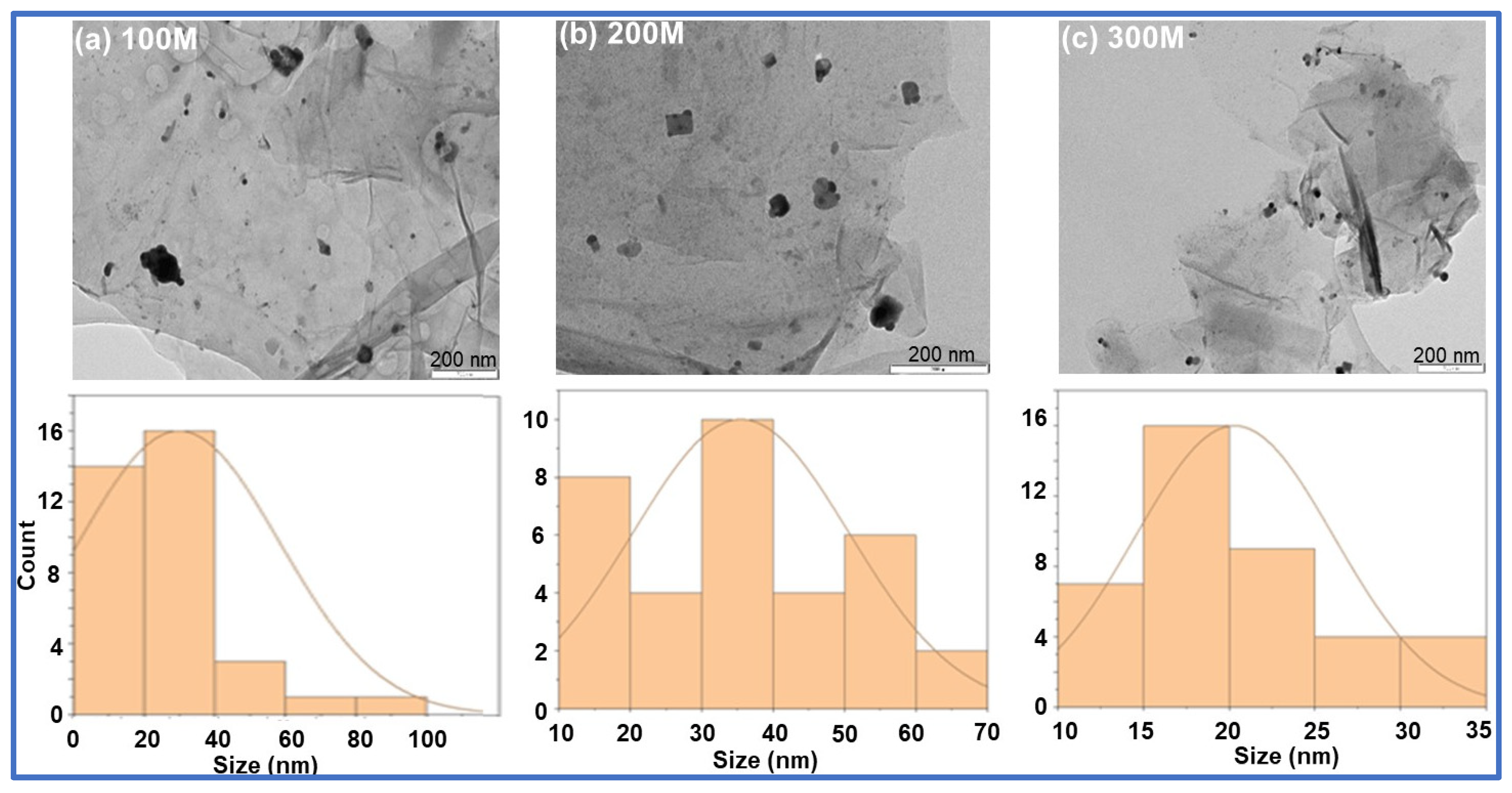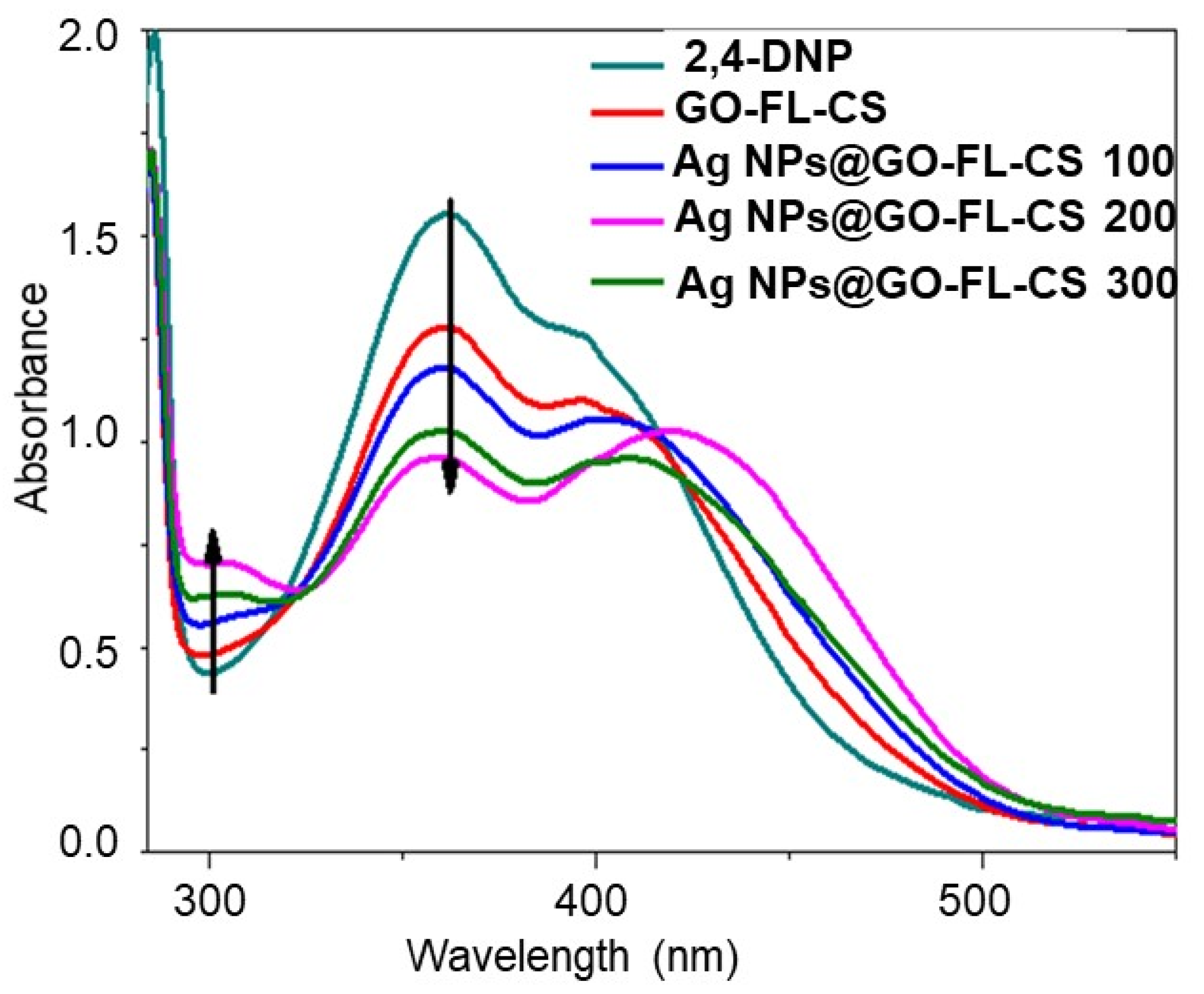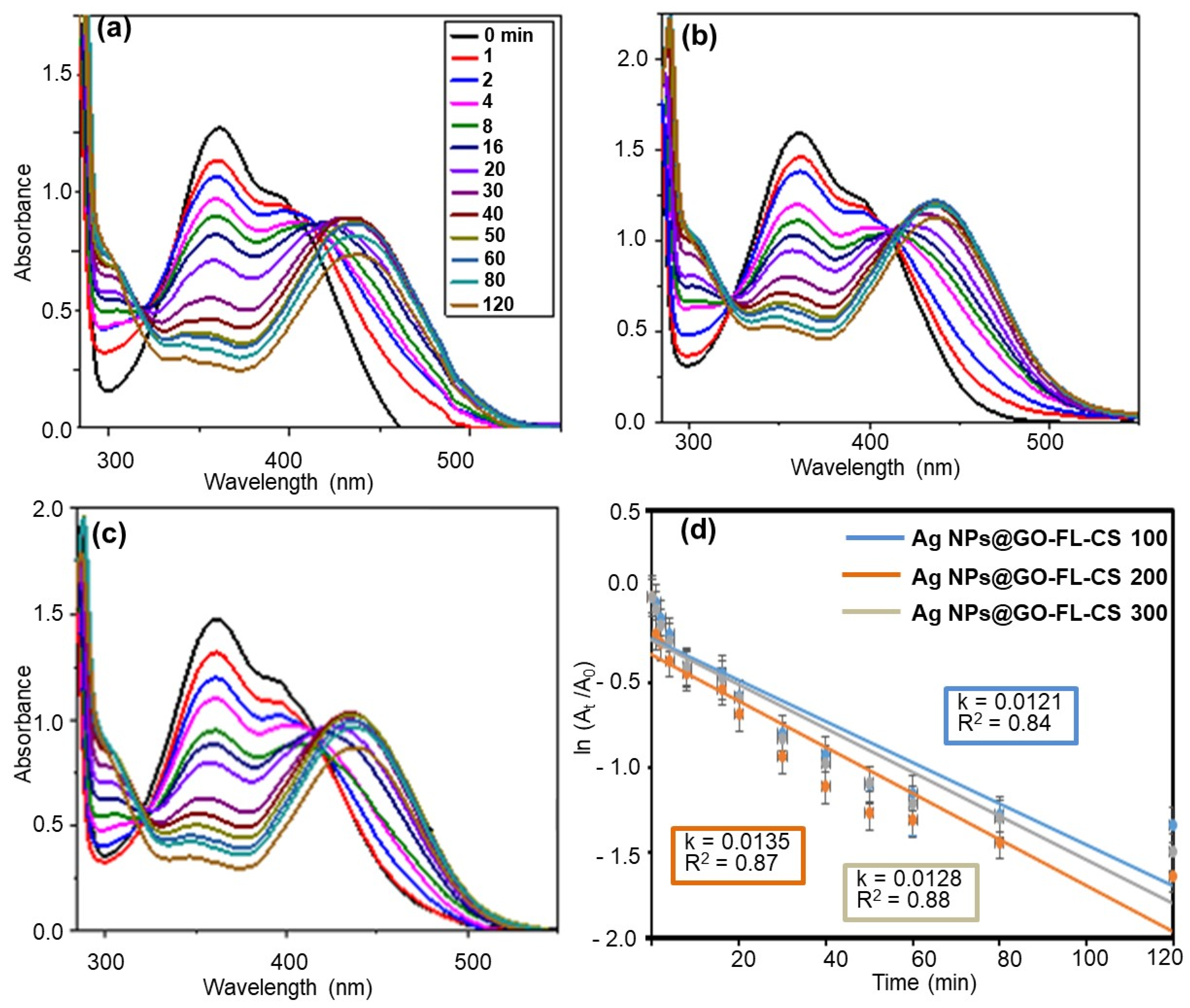In Situ Stabilisation of Silver Nanoparticles at Chitosan-Functionalised Graphene Oxide for Reduction of 2,4-Dinitrophenol in Water
Abstract
:1. Introduction
2. Materials and Methods
2.1. Materials
2.2. Preparation of GO Sheets
2.3. Preparation of Fumaryl Chloride (FL)
2.4. Preparation of FL-CS
2.5. Preparation of GO-FL-CS Membrane
2.6. Preparation of GO-FL-CS Membrane Decorated with Ag NPs (Ag NPs@GO-FL-CS)
2.7. Characterisation
2.8. Catalytic Reduction Experiments
3. Results and Discussion
3.1. Synthesis of Ag NPs@GO-FL-CS
3.2. Characterisation
3.3. Catalytic Reduction of 2,4-DNP
3.3.1. Optimisation of Ag Loading
3.3.2. Influence of Ag NPs@GO-FL-CS Dosage
3.3.3. Mechanism of Reduction
3.3.4. Reusability of the Ag NPs@GO-FL-CS Nanocatalyst
4. Conclusions
Author Contributions
Funding
Institutional Review Board Statement
Informed Consent Statement
Acknowledgments
Conflicts of Interest
References
- Manju, S.; Sagar, N. Renewable energy integrated desalination: A sustainable solution to overcome future freshwater scarcity in India. Renew. Sustain. Energy Rev. 2017, 73, 594–609. [Google Scholar] [CrossRef]
- Khatri, N.; Tyagi, S. Influences of natural and anthropogenic factors on surface and groundwater quality in rural and urban areas. Front. Life Sci. 2015, 8, 23–39. [Google Scholar] [CrossRef]
- Rajput, R.S.; Pandey, S.; Bhadauria, S. Status of water pollution in relation to industrialisation in Rajasthan. Rev. Environ. Health 2017, 32, 245–252. [Google Scholar] [CrossRef]
- Chen, M.-Y.; Ike, M.; Fujita, M. Acute toxicity, mutagenicity, and estrogenicity of bisphenol-A and other bisphenols. Environ. Toxicol. 2002, 17, 80–86. [Google Scholar] [CrossRef]
- Traversi, D.; Degan, R.; De Marco, R.; Gilli, G.; Pignata, C.; Villani, S.; Bono, R. Mutagenic properties of PM2. 5 urban pollution in the northern Italy: The nitro-compounds contribution. Environ. Int. 2009, 35, 905–910. [Google Scholar] [CrossRef] [PubMed]
- Zhang, Q.; Bu, J.; Wang, J.; Sun, C.; Zhao, D.; Sheng, G.; Xie, X.; Sun, M.; Yu, L. Highly efficient hydrogenation of nitrobenzene to aniline over Pt/CeO2 catalysts: The shape effect of the support and key role of additional Ce3+ sites. ACS Catal. 2020, 10, 10350–10363. [Google Scholar] [CrossRef]
- Bhosale, M.A.; Bhanage, B.M. Silver nanoparticles: Synthesis, characterisation and their application as a sustainable catalyst for organic transformations. Curr. Org. Chem. 2015, 19, 708–727. [Google Scholar] [CrossRef]
- Paumo, H.K.; Dalhatou, S.; Katata-Seru, L.M.; Kamdem, B.P.; Tijani, J.O.; Vishwanathan, V.; Kane, A.; Bahadur, I. TiO2 assisted photocatalysts for degradation of emerging organic pollutants in water and wastewater. J. Mol. Liq. 2021, 331, 115458. [Google Scholar] [CrossRef]
- Pérez-Mayoral, E.; Calvino-Casilda, V.; Soriano, E. Metal-supported carbon-based materials: Opportunities and challenges in the synthesis of valuable products. Catal. Sci. Technol. 2016, 6, 1265–1291. [Google Scholar] [CrossRef]
- Bhalothia, D.; Krishnia, L.; Yang, S.-S.; Yan, C.; Hsiung, W.-H.; Wang, K.-W.; Chen, T.-Y. Recent advancements and future prospects of noble metal-based heterogeneous nanocatalysts for oxygen reduction and hydrogen evolution reactions. Appl. Sci. 2020, 10, 7708. [Google Scholar] [CrossRef]
- Bullock, R.M. Reaction: Earth-abundant metal catalysts for energy conversions. Chem 2017, 2, 443–447. [Google Scholar] [CrossRef] [Green Version]
- Tabish, T.A.; Memon, F.A.; Gomez, D.E.; Horsell, D.W.; Zhang, S. A facile synthesis of porous graphene for efficient water and wastewater treatment. Sci. Rep. 2018, 8, 1817. [Google Scholar] [CrossRef]
- Dideikin, A.T.; Vul, A.Y. Graphene oxide and derivatives: The place in graphene family. Front. Phys. 2019, 6, 149. [Google Scholar] [CrossRef]
- Georgakilas, V.; Otyepka, M.; Bourlinos, A.B.; Chandra, V.; Kim, N.; Kemp, K.C.; Hobza, P.; Zboril, R.; Kim, K.S. Functionalization of graphene: Covalent and non-covalent approaches, derivatives and applications. Chem. Rev. 2012, 112, 6156–6214. [Google Scholar] [CrossRef] [PubMed]
- Guo, S.; Raya, J.; Ji, D.; Nishina, Y.; Ménard-Moyon, C.; Bianco, A. Is carboxylation an efficient method for graphene oxide functionalization? Nanoscale Adv. 2020, 2, 4085–4092. [Google Scholar] [CrossRef]
- Tamakloe, W.; Agyeman, D.A.; Park, M.; Yang, J.; Kang, Y.-M. Polydopamine-induced surface functionalisation of carbon nanofibers for Pd deposition enabling enhanced catalytic activity for the oxygen reduction and evolution reactions. J. Mater. Chem. A 2019, 7, 7396–7405. [Google Scholar] [CrossRef]
- Park, S.Y.; Chung, J.W.; Priestley, R.D.; Kwak, S.-Y. Covalent assembly of metal nanoparticles on cellulose fabric and its antimicrobial activity. Cellulose 2012, 19, 2141–2151. [Google Scholar] [CrossRef]
- Gu, B.; Jiang, Q.; Luo, B.; Liu, C.; Ren, J.; Wang, X.; Wang, X. A sandwich-like chitosan-based antibacterial nanocomposite film with reduced graphene oxide immobilised silver nanoparticles. Carbohydr. Polym. 2021, 260, 117835. [Google Scholar] [CrossRef]
- Das, R.; Sypu, V.S.; Paumo, H.K.; Bhaumik, M.; Maharaj, V.; Maity, A. Silver decorated magnetic nanocomposite (Fe3O4@PPy-MAA/Ag) as highly active catalyst towards reduction of 4-nitrophenol and toxic organic dyes. Appl. Catal. B 2019, 244, 546–558. [Google Scholar] [CrossRef]
- Poh, H.L.; Šaněk, F.; Ambrosi, A.; Zhao, G.; Sofer, Z.; Pumera, M. Graphenes prepared by Staudenmaier, Hofmann and Hummers methods with consequent thermal exfoliation exhibit very different electrochemical properties. Nanoscale 2012, 4, 3515–3522. [Google Scholar] [CrossRef] [PubMed]
- Das, S.; Das, U.; Varela-Ramirez, A.; Lema, C.; Aguilera, R.J.; Balzarini, J.; De Clercq, E.; Dimmock, S.G.; Gorecki, D.K.J.; Dimmock, J.R. Bis [3,5-bis(benzylidene)-4-oxo-1-piperidinyl]amides: A novel class of potent cytotoxins. ChemMedChem 2011, 6, 1892–1899. [Google Scholar] [CrossRef] [PubMed] [Green Version]
- Spatz, S.M. Process for Preparing Fumaryl Cheloride. U.S. Patent 2,653,168, 22 September 1953. [Google Scholar]
- Wu, S.; Zeng, F.; Zhu, H.; Tong, Z. Energy and electron transfers in photosensitive chitosan. J. Am. Chem. Soc. 2005, 127, 2048–2049. [Google Scholar] [CrossRef]
- Li, P.; Wang, Y.; Huang, H.; Ma, S.; Yang, H.; Xu, Z.L. High efficient reduction of 4-nitrophenol and dye by filtration through Ag NPs coated PAN-Si catalytic membrane. Chemosphere 2021, 263, 127995. [Google Scholar] [CrossRef]
- Queiroz, M.F.; Melo, K.R.T.; Sabry, D.A.; Sassaki, G.L.; Rocha, H.A.O. Does the use of chitosan contribute to oxalate kidney stone formation? Mar. Drugs 2015, 13, 141–158. [Google Scholar] [CrossRef] [PubMed]
- Wang, X.; Tang, R.; Zhang, Y.; Yu, Z.; Qi, C. Preparation of a novel chitosan based biopolymer dye and application in wood dyeing. Polymers 2016, 8, 338. [Google Scholar] [CrossRef]
- Kim, Y.; Lee, D.; Kim, S.Y.; Kang, E.; Kim, C.K. Nanocomposite synthesis of nanodiamond and molybdenum disulphide. Nanomaterials 2019, 9, 927. [Google Scholar] [CrossRef] [Green Version]
- Sun, L.; Du, Y.; Fan, L.; Chen, X.; Yang, J. Preparation, characterisation and antimicrobial activity of quaternized carboxymethyl chitosan and application as pulp-cap. Polymer 2006, 47, 1796–1804. [Google Scholar] [CrossRef]
- Xue, J.; Wang, S.; Han, X.; Wang, Y.; Hua, X.; Li, J. Chitosan-functionalized graphene oxide for enhanced permeability and antifouling of ultrafiltration membranes. Chem. Eng. Technol. 2018, 41, 270–277. [Google Scholar] [CrossRef] [Green Version]
- Guilger-Casagrande, M.; de Lima, R. Synthesis of silver nanoparticles mediated by fungi: A review. Front. Bioeng. Biotechnol. 2019, 7, 287. [Google Scholar] [CrossRef] [PubMed] [Green Version]
- Chigondo, M.; Paumo, H.K.; Bhaumik, M.; Pillay, K.; Maity, A. Magnetic arginine-functionalized polypyrrole with improved and selective chromium(VI) ions removal from water. J. Mol. Liq. 2019, 275, 778–791. [Google Scholar] [CrossRef]
- Espinoza, R.C.; Sierra-Gómez, U.; López, C.M.; González-Gutiérrez, L.V.; Castillo, B.E.; Bárcenas, G.L.; Peña, E.A.E.; Bueno, J.J.P.; Tavizón, S.F.; Sánchez, B.L.E. Zwitterion-decorated graphene oxide nanosheets with aliphatic amino acids under specific pH conditions. Appl. Surf. Sci. 2021, 555, 149723. [Google Scholar] [CrossRef]
- Soomro, S.A.; Gul, I.H.; Naseer, H.; Marwat, S.; Mujahid, M. Improved performance of CuFe2O4/rGO nanohybrid as an anode material for lithium-ion batteries prepared via facile one-step method. Curr. Nanosci. 2019, 15, 420–429. [Google Scholar] [CrossRef]
- Zhang, Y.; Xue, C.; Xue, Y.; Gao, R.; Zhang, X. Determination of the degree of deacetylation of chitin and chitosan by X-ray powder diffraction. Carbohydr. Res. 2005, 340, 1914–1917. [Google Scholar] [CrossRef] [PubMed]
- Johra, F.T.; Lee, J.-W.; Jung, W.-G. Facile and safe graphene preparation on solution based platform. J. Ind. Eng. Chem. 2014, 20, 2883–2887. [Google Scholar] [CrossRef]
- Mohan, Y.M.; Vimala, K.; Thomas, V.; Varaprasad, K.; Sreedhar, B.; Bajpai, S.K.; Raju, K.M. Controlling of silver nanoparticles structure by hydrogel networks. J. Colloid Interface Sci. 2010, 342, 73–82. [Google Scholar] [CrossRef]
- Rajesh, R.; Sujanthi, E.; Kumar, S.S.; Venkatesan, R. Designing versatile heterogeneous catalysts based on Ag and Au nanoparticles decorated on chitosan functionalised graphene oxide. Phys. Chem. Chem. Phys. 2015, 17, 11329–11340. [Google Scholar] [CrossRef]
- Zhang, Z.; Shao, C.; Zou, P.; Zhang, P.; Zhang, M.; Mu, J.; Guo, Z.; Li, X.; Wang, C.; Liu, Y. In situ assembly of well-dispersed gold nanoparticles on electrospun silica nanotubes for catalytic reduction of 4-nitrophenol. Chem. Commun. 2011, 47, 3906–3908. [Google Scholar] [CrossRef] [PubMed]
- Kimio, S. Absorption Spectra of Nitrobenzene Derivatives. I. Spectral Features of o-, m- and p-Isomers. Bull. Chem. Soc. Jpn. 1960, 33, 1640–1645. [Google Scholar] [CrossRef]
- Karakas, K.; Celebioglu, A.; Celebi, M.; Uyar, T.; Zahmakiran, M. Nickel nanoparticles decorated on electrospun polycaprolactone/chitosan nanofibers as flexible, highly active and reusable nanocatalyst in the reduction of nitrophenols under mild conditions. Appl. Catal. B 2017, 203, 549–562. [Google Scholar] [CrossRef]
- Tang, H.; Zhao, Y.; Shan, S.; Yang, X.; Liu, D.; Cui, F.; Xing, B. Theoretical insight into the adsorption of aromatic compounds on graphene oxide. Environ. Sci. Nano 2018, 5, 2357–2367. [Google Scholar] [CrossRef]
- Li, M.; Chen, G. Revisiting catalytic model reaction p-nitrophenol/NaBH4 using metallic nanoparticles coated on polymeric spheres. Nanoscale 2013, 5, 11919–11927. [Google Scholar] [CrossRef] [Green Version]
- Huang, J.; Vongehr, S.; Tang, S.; Lu, H.; Meng, X. Highly catalytic Pd-Ag bimetallic dendrites. J. Phys. Chem. C 2010, 114, 15005–15010. [Google Scholar] [CrossRef]
- van Hoof, A.J.F.; Hermans, E.A.R.; van Bavel, A.P.; Friedrich, H.; Hensen, E.J.M. Structure sensitivity of silver-catalysed ethylene epoxidation. ACS Catal. 2019, 9, 9829–9839. [Google Scholar] [CrossRef]
- Wang, Z.; Su, R.; Wang, D.; Shi, J.; Wang, J.-X.; Pu, Y.; Chen, J.-F. Sulfurized graphene as efficient metal-free catalysts for reduction of 4-nitrophenol to 4-aminophenol. Ind. Eng. Chem. Res. 2017, 56, 13610–13617. [Google Scholar] [CrossRef]
- Portada, T.; Margetić, D.; Štrukil, V. Mechanochemical catalytic transfer hydrogenation of aromatic nitro derivatives. Molecules 2018, 23, 3163. [Google Scholar] [CrossRef] [Green Version]
- Dejmkova, H.; Stoica, A.I.; Barek, J.; Zima, J. Voltammetric and amperometric determination of 2,4-dinitrophenol metabolites. Talanta 2011, 85, 2594–2598. [Google Scholar] [CrossRef]
- Liu, Y.; Zhu, L.; Zhang, Y.; Tang, H. Electrochemical sensoring of 2,4-dinitrophenol by using composites of graphene oxide with surface molecular imprinted polymer. Sens. Actuators B Chem. 2012, 171–172, 1151–1158. [Google Scholar] [CrossRef]
- Zhang, T.; Lang, Q.; Yang, D.; Li, L.; Zeng, L.; Zheng, C.; Li, T.; Wei, M.; Liu, A. Simultaneous voltammetric determination of nitrophenol isomers at ordered mesoporous carbon modified electrode. Electrochim. Acta 2013, 106, 127–134. [Google Scholar] [CrossRef]











| Ag NPs@GO-FL-CS | Silver Nanoparticles Stabilised at Graphene Oxide-Chitosan Membrane |
|---|---|
| CS | Chitosan |
| CSA | Chlorosulfonic acid |
| DNP | Dinitrophenol |
| FL | Fumaryl chloride |
| FL-CS | Covalently bonded fumaryl chloride and chitosan |
| GO | Graphene oxide |
| GO-FL-CS | Crosslinked graphene oxide-chitosan using fumaryl chloride |
| E | Potential (V) |
| I | Current (µA) |
| k | Apparent rate constants (min−1) |
| STP | Standard temperature and pressure |
| Ag NPs@GO-FL-CS 100 | Ag NPs@GO-FL-CS 200 | Ag NPs@GO-FL-CS 300 | |
|---|---|---|---|
| Element | Weight % | Weight % | Weight % |
| C | 51.96 | 48.49 | 49.61 |
| O | 22.98 | 11.19 | 22.09 |
| S | 10.32 | 7.88 | 5.55 |
| Cl | 3.29 | 4.60 | Not detected |
| Ag | 11.17 | 22.27 | 21.56 |
Publisher’s Note: MDPI stays neutral with regard to jurisdictional claims in published maps and institutional affiliations. |
© 2021 by the authors. Licensee MDPI, Basel, Switzerland. This article is an open access article distributed under the terms and conditions of the Creative Commons Attribution (CC BY) license (https://creativecommons.org/licenses/by/4.0/).
Share and Cite
Makaudi, R.; Paumo, H.K.; Pone, B.K.; Katata-Seru, L. In Situ Stabilisation of Silver Nanoparticles at Chitosan-Functionalised Graphene Oxide for Reduction of 2,4-Dinitrophenol in Water. Polymers 2021, 13, 3800. https://doi.org/10.3390/polym13213800
Makaudi R, Paumo HK, Pone BK, Katata-Seru L. In Situ Stabilisation of Silver Nanoparticles at Chitosan-Functionalised Graphene Oxide for Reduction of 2,4-Dinitrophenol in Water. Polymers. 2021; 13(21):3800. https://doi.org/10.3390/polym13213800
Chicago/Turabian StyleMakaudi, Rebaone, Hugues Kamdem Paumo, Boniface Kamdem Pone, and Lebogang Katata-Seru. 2021. "In Situ Stabilisation of Silver Nanoparticles at Chitosan-Functionalised Graphene Oxide for Reduction of 2,4-Dinitrophenol in Water" Polymers 13, no. 21: 3800. https://doi.org/10.3390/polym13213800
APA StyleMakaudi, R., Paumo, H. K., Pone, B. K., & Katata-Seru, L. (2021). In Situ Stabilisation of Silver Nanoparticles at Chitosan-Functionalised Graphene Oxide for Reduction of 2,4-Dinitrophenol in Water. Polymers, 13(21), 3800. https://doi.org/10.3390/polym13213800






